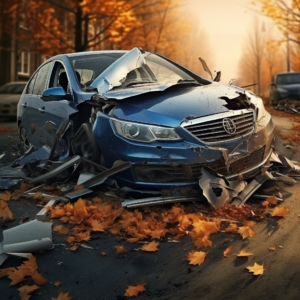Overview of Car Accident Law in Mississauga, Ontario
Mississauga, Ontario, as a bustling city in the Greater Toronto Area, is no stranger to congested roadways and traffic-related events. The complexities of vehicle accident rules in this region can often confound both victims and perpetrators. This page intends to provide a thorough summary of vehicle accident law in Mississauga, Ontario.

Understanding Car Accident Laws
Car accidents in Mississauga are primarily governed by two key statutes - the Highway Traffic Act and the Insurance Act. The Highway Traffic Act dictates the rules of the road and provides the standards for vehicle operation. Violations of this Act can result in fines, demerit points, license suspension, and even jail time, depending on the severity of the offense.
The Insurance Act of Ontario, on the other hand, details how insurance claims should be handled following an accident. It's essential to note that Ontario operates under a 'no-fault' insurance system. This system doesn't mean no one is at fault in an accident; rather, regardless of who is at fault, each person deals with their own insurance company for claims.

Responsibilities after a Car Accident
If you are unfortunate enough to be involved in an automobile accident, the law imposes several obligations on you. First and foremost, if there are injuries or deaths, or if the total damage to all vehicles involved appears to be more than $2,000, the accident must be reported to the police. Failure to do so can result in serious consequences.
After ensuring everyone's safety and reporting to the police, you should notify your insurance company about the incident. In Ontario, you typically have seven days to inform your insurance provider of the accident, or as soon as reasonably possible.
Personal Injury Claims after a Car Accident
Following an automobile collision, individuals in Ontario can file personal injury claims. This procedure comprises filing a claim for compensation for injuries received as a result of the accident. However, it is critical to remember the statute of limitations. Most personal injury claims must be filed within two years of the date of the accident.
Determining Fault in a Car Accident
The Insurance Act’s Fault Determination Rules are critical in determining fault in an accident. These rules cover a variety of events as well as the degree of culpability assigned to each driver. It is critical to emphasise that these regulations apply regardless of road or weather conditions, visibility, or pedestrian behaviours.
Consequences of Driving Uninsured in Ontario
Driving without valid auto insurance is a serious offence in Ontario. For a first offence, they might range from $5,000 to $25,000 in fines. It may also result in the suspension of your driver’s licence and a significant increase in your insurance costs.
Hiring a Car Accident Lawyer in Mississauga, Ontario
Given the complexities of automobile accident legislation, employing an experienced car accident lawyer mississauga may be advantageous. A lawyer can help you through complicated insurance claims and guarantee that you get the amount you deserve.
Real-life Case Studies and Precedents in Car Accident Law
Car accident legislation is as complex and varied as the accidents themselves. Real-life case studies and precedents are frequently used as a compass when it comes to comprehending legal ideas. They provide light not just on legal applications, but also on the complexities of the judiciary’s decision-making process. This article examines some notable vehicle accident cases and their impact on Ontario car accident law.
Case Study 1: The Role of Contributory Negligence - Chen v. Barrett, 2016
The concept of contributory negligence became a focal point in the 2016 case Chen v. Barrett. Chen, a pedestrian, was struck by a vehicle driven by Barrett in the early morning hours of this occurrence. Barrett, for not paying attention to the road, and Chen, for walking onto the street without checking for approaching vehicles, were both judged equally at fault by the court.
This case demonstrated the theory of contributory negligence, which states that the plaintiff’s carelessness may have contributed to their injury. It further emphasised that not only drivers, but also pedestrians, had a responsibility of care on the highways.
Case Study 2: Understanding Catastrophic Impairment - Pastore v. Aviva Canada, 2012
The 2012 case of Pastore v. Aviva Canada centred with the definition of “catastrophic impairment” under the Statutory Accident Benefits Schedule (SABS). Ms. Pastore was in an accident that resulted in severe impairments. However, there was some disagreement over whether her injuries met the SABS criteria of “catastrophic impairment.”
The Supreme Court of Canada found in Pastore’s favour, noting that a single significant impairment in any category of functional loss might be considered a “catastrophic impairment.” This decision offered much-needed clarity on how to interpret the “catastrophic impairment” clause, which will assist future accident victims in their claims.
Case Study 3: Settling Accident Benefits Claims - El-Khodr v. Lackie, 2017
The 2017 case of El-Khodr v. Lackie was about settling accident benefits claims. Mr. El-Khodr was seriously injured in a car accident and sued the at-fault motorist for compensation. The dispute arose as to whether the tort insurance might deduct the injured party’s accident benefits from the awarded damages.
The Ontario Court of Appeal ruled that the tort insurance could deduct particular accident benefits received. This decision was crucial in understanding the interaction of tort and accident benefits in personal injury litigation.
Case Study 4: The Threshold for Pain and Suffering - Buckley v. Holmes, 2020
The plaintiff in Buckley v. Holmes, 2020 suffered multiple injuries in an automobile accident. However, when she sought compensation for pain and suffering, the jury determined that her injuries did not exceed the legal threshold for such damages, leaving her without non-pecuniary compensation.
The case emphasised the tight interpretation of the legal threshold for pain and suffering damages under Ontario’s Insurance Act, emphasising how difficult it is to reach this standard.
The Impact of these Cases on Law and Society
Real-world examples and precedents have a significant impact on legal interpretations and applications. They not only assist lawyers in case strategy, but they also guide judges in their rulings. The preceding decisions have had a significant impact on Ontario’s car accident law, ranging from legal phrase interpretation to fault determination.
While these decisions have provided clarity in some areas, the ever-changing nature of accident scenarios and legal concepts means that the law is still evolving. As a result, being up to date on new case law and legislative changes is critical.
Responsibilities After a Car Accident in Ontario

It is critical to understand your legal responsibilities and rights
A car collision can be a traumatic event. In the midst of the initial shock and confusion, it is critical to understand your legal responsibilities and rights. This article discusses the duties that a person must complete following an automobile accident in Ontario.
-
Ensure Safety and Seek Medical Attention
The first priority following an accident is to determine whether or not there are any injuries. If someone is injured, dial 911 immediately. Even small injuries should be treated as soon as possible because some injuries do not display symptoms right away.
- Reporting the Accident
According to Ontario law, it is mandatory to report car accidents that result in injuries or fatalities, or if the total damage to all vehicles involved exceeds $2,000. In such cases, it is critical to contact the authorities as soon as possible.
It's crucial to share details with everyone involved in the accident. Information such as names, addresses, contact details, driver's license numbers, and insurance information should be exchanged. Additionally, you should make a record of the accident scene, noting the location, time, weather conditions, and possible witnesses. This information could prove invaluable if you need to file an insurance claim or in case there is a disagreement regarding the circumstances of the accident.
- Exchange Information
It is critical to exchange information with all parties involved in the accident. This should include names, addresses, phone numbers, driver's licence numbers, and insurance information. It's also a good idea to take pictures of the accident scene, including the location, the time it happened, the weather, and the presence of any potential witnesses. This information may be necessary if you need to file an insurance claim or if there is a disagreement about the circumstances of the incident.
- Notify Your Insurance Company
In Ontario, it's legally mandated to inform your insurance provider promptly following a car accident, irrespective of who is to blame. It's vital to give your insurer a comprehensive account of the accident, as any inaccuracies or omissions could impact your claim. If you plan to claim for damages or injuries, it's advisable to consult with a lawyer before providing a statement to your insurance company.
- Document the Accident
Thoroughly documenting the accident can be useful for future legal or insurance processes. This includes photographing the accident scene, your injuries, and vehicle damage. It is also advisable to keep a personal record of any medical treatments or expenses incurred as a result of the event.
- Understand Your Coverage
Finally, understanding your insurance coverage is your job. This includes understanding what your policy covers, how to file a claim, and your rights if your claim is refused. If you have optional loss of income or medical coverage, you may be eligible for additional benefits.
Legal Representation Post-Accident
The aftermath of an automobile collision can be difficult to navigate. As a result, speaking with a vehicle accident lawyer may be advantageous. They can walk you through the procedure, ensuring that you meet all legal obligations and that your rights are protected.

